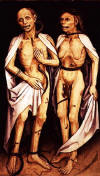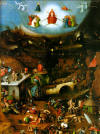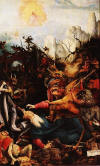|
Search:: Artists Alphabetically 100 Greatest Painters 50 Greatest Paintings Art Movements The Effect of Black Death on Art and Artists in the Medieval Period Life in the Medieval Period In the Medieval period, people concentrated mainly on the church, God, and personal salvation. Life in Medieval Europe was primitive and far more difficult than that of Imperial Rome. Average folks were lucky to eat meat a couple of times a year and usually bathed once a decade if that. People who smelled pleasant were suspected of witchcraft or at the very least heresy and often found themselves burned at the stake or ostracized and left on the road to fend for themselves. A foul bodily odor was considered the norm and accepted. Most peasants lived until the ripe old age of 35 and often died of infections brought by broken bones, carbunkles, ill vapors, boils, leprosy or venereal diseases. The average life expectancy did not allow for much planning for the future. Christianity and the promise of landing in a heavenly realm provided hope once the physical body and gone to the worms. When the plague first began it's rampage across the land, Europe was emerging from the "dark ages" trying to put unpleasant memories behind it and move on to a more enlightened era. Barbarians no longer ran rough shod, putting entire villages to the torch and slaughtering the local peasants. Without the constant fear of invasion, art and architecture found fertile ground to grow. Medieval painters were not simply anonymous lowly craftsmen, but well respected professionals. They were held in high esteem and often interacted with princes and popes. The arrival of plague harkened in a new darker era of painting. Paintings were overflowing with tortured souls, death, dying, fire and brimstone. Thousands of painters, craftsmen, patrons of the arts perished during the mid 14th century. The heart of the cultural world was torn open. The horrors of the black death pervaded all aspects of Medieval culture and especially art. The effects were lasting, bringing a somber darkness to visual art, literature, and music. The dreadful trauma of this era instigated the imaginations of writers and painters in worrying and unsettling ways for decades to follow. The insecurity of daily survival created a atmosphere of gloom and doom influencing artist to move away from optimistic themes and turn to images of Hell, Satan and the Grim Reaper. Many painters simply gave up art believing that it was hopeless to try and create beauty in a hellish world. |
|
|
What was the Plague? Bubonic plague is a bacillus, an organism, most often carried by infested rats who were plague-ridden with fleas. The infected fleas, seeking a new blood meal jumped off their rodent hosts and leapt onto a human, biting their new victim causing infection. Symptoms include swelling of the lymph nodes, high fevers, large blackish pustules that soon burst and ooze a foul liquid, aching limbs, and vomiting of blood. Finally the victim became an unrecognizable, grotesque monster. The died by the millions, alone in agony, their kinsmen fleeing in terror. Government and Clergy tried to control the catastrophe, but the disease progressed relentlessly, eventually wiping out 80 million people. Preventing the Plague Many believed that the disease was spread upon the air, So, the survivors turned to incense, fragrant oils and perfumes to ward off the deadly vapors that they believed to be causing the infection. With so many bodies piling up, if nothing else the air smelled a bit better. Towns rang church bells and held parades where all the citizens paraded through the streets banging pots and pans to drive the plague away. Gypsies, Jews, foreign travelers, and lepers were hunted down and killed as they were believed to be the carriers of the disease. Medieval entrepreneurs made a fortune selling talismans, lucky charms and enchantments. Peasants who could not afford such luxuries simply wore a necklace of garlic around their necks or crushed herbs in their pockets. People were frantic for a remedy and would try anything, no matter how peculiar or bizarre. 
A Medieval Song about the Plague "A
sickly season," the
merchant said, "I
came away," the merchant
said, The Meaning of Sacred Symbols in Paintings. Most prominently featured symbols and their meaning:
Require more information about The Consequences of Black Death on Art and painters in the Medieval Period in Art History? Type your query in art into the google search box below and poke around every nook and cranny of the known universe for information this subject. Search Here © HistoryofPainters.com If you like this page and wish to share it, you are welcome to link to it, with our thanks. If you feel you have worthwhile information you would like to contribute we would love to hear from you. We collect essential biographical information and artist quotes from folks all over the globe and appreciate your participation. When submitting please, if possible, site the source and provide English translation. Email to millardmulch@gmail.com copyright 2011 - historyofpainters.com
|
|
Important Medieval
Painters |



